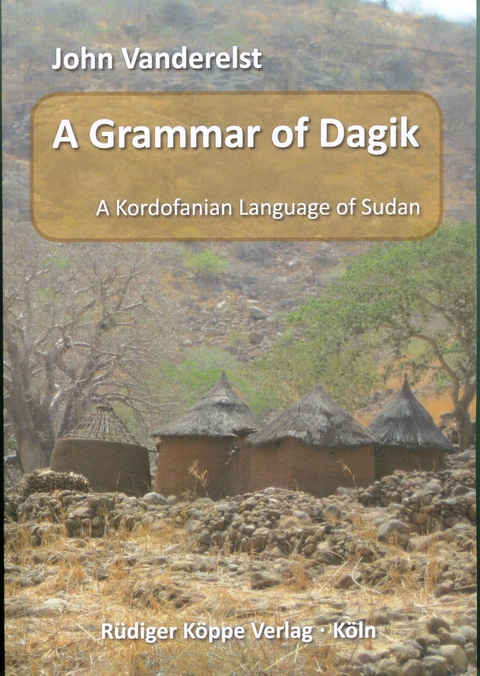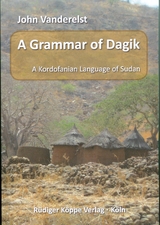A Grammar of Dagik
A Kordofanian Language of Sudan
Seiten
2016
Köppe, R (Verlag)
978-3-89645-566-6 (ISBN)
Köppe, R (Verlag)
978-3-89645-566-6 (ISBN)
- Keine Verlagsinformationen verfügbar
- Artikel merken
Die Sprache Dagik wird in den Nuba-Bergen in der Republik Sudan gesprochen. Dagik gehört zur Talodi-Untergruppe der kordofanischen Sprachfamilie. Dagik-Sprecher nennen sich selbst Duwa und ihre Sprache Dhaduwa. Sie sind auch als Nuba-Dagik oder Masakin bekannt. Es handelt sich bei den Sprechern um eine kleine ethnische Gruppe, mit etwa 15.000 bis 20.000 Sprechern. Sie leben in Dörfern im Buram-Distrikt im Südosten der Provinz South Kordofan. Weitere Dagik-Sprecher leben in Omdurman, Gedaref und im Südsudan.
Hinweise zum Dagik in der Literatur, linguistisch als auch ethnografisch, liefern Nadel (1947), Stevenson (1956-57), Riefenstahl (1974) und Schadeberg (1981). Über die Sprache war jedoch wenig bekannt.
Diese Monographie ist die erste veröffentlichte Grammatik einer Talodi-Sprache. Im Rahmen einer Feldforschung wurden die Daten vom Autor zusammengetragen. Das Korpus beinhaltet eine Sprachdatenbank sowie eine Satz- und Textkollektion. Die deskriptive Beschreibung bildet den Rahmen des Werks: Kapitel 2 liefert einen Überblick über die Struktur der Sprache, von der Phonologie bis zur Satzstruktur. Im Kapitel 3 wird gezeigt, dass sich die nominale Morphologie durch ein Nominalklassen- und Kongruenzsystem auszeichnet. Ableitungssuffixe kennzeichnen die verbale Morphologie (Kapitel 4).
Des Weiteren werden noch Wortklassen wie Adjektive, Pronomen und Indexe beschrieben (Kapitel 5 und 6). Kapitel 7 beinhaltet eine detaillierte Beschreibung des Ausdrucks Raum. Die Analyse von Bewegung zeigt, dass zwischen “motion sensitive to the position of the deictic center, and motion sensitive to the position of the ground” unterschieden werden muss. Die Monographie wird durch einen Vorschlag für eine Orthographie, einen interlinisierten Text und einer Wortliste vervollständigt.
REZENSION
„At first it seems that ‚A grammar of Dagik‘ is not difficult to read, but once you try to dig deeper, you realize how complex many issues are. Each subject is dealt with on just a few pages, not enough to answer all questions that come up. Looking at other recent studies of Kordofanian, notably on Lumun (TALODI; Smits 2017) but also on Moro (HEIBAN, e.g. Rose 2013), the lack of tonal data and analysis makes one suspect that many details of morphology and syntax remain undetected. “A grammar of Dagik” may have shortcomings in coverage and in analysis, but that is what one may expect from a pioneering work by a young scholar presenting an uncharted language from a very poorly known language group.
For some scholars, Kordofanian languages derive their interest primarily from their isolated position: they are the only real exclave of anotherwise contiguous large language family, i.e. Niger-Congo, and even within the assumed NC family tree they occupy a rather isolated position (or positions, see Dimmendaal 2014). ‚A grammar of Dagik‘ again shows that the study of any of these language substantially adds to our knowledge and understanding of African languages and of human language.
(Thilo C. Schadeberg in „Linguistique et Langues Africaines“ 4/2018, 133-139)
Unter den nachstehenden Verweisen finden Sie weitere Werke zu kordofanischen Sprachen und Kulturen des Sudan in unserem Programm:
„Nayayirak tamaa dumurik [Speak Tima!]“, ISBN 978-3-89645-413-3.
„Nuba Mountain Language Studies“, ISBN 978-3-89645-427-0.
„The Nominal and Verbal Morphology of Tima“, ISBN 978-3-89645-559-8.
„The Phonology of Koalib – A Kordofanian Language of the Nuba Mountains (Sudan)“, ISBN 978-3-89645-552-9.
„The Tima of the Nuba Mountains (Sudan)“, ISBN 978-3-89645-898-8.
„Tira and Otoro – Two Kordofanian Grammars by Roland C. Stevenson“, ISBN 978-3-89645-173-6.
***********************************
The Dagik language is spoken in the Nuba Mountains in the Republic of the Sudan. Dagik speakers call themselves Duwa and their language Dhaduwa. The Dagik home area consists of scattered villages in the Buram district, southeast of Kadugli. Large Dagik communities also live in Omdurman and Gedaref.
The Dagik language is spoken in the Nuba Mountains in the Republic of the Sudan. It belongs to the Talodi subgroup of (what is known as) the Kordofanian language family.
Dagik speakers call themselves Duwa and their language Dhaduwa. To outsiders, they are also variously known as Nuba Dagik or Masakin. It is a small ethnic group consisting of 15,000 to 20,000 speakers. The Dagik home area consists of scattered villages in the Buram district, southeast of Kadugli, in the South Kordofan province. Large Dagik communities also live in Omdurman, Gedaref, and in South Sudan.
Prominent previous references to the Dagik in the literature, both linguistic and ethnographic, include Nadel (1947), Stevenson (1956-57), Riefenstahl (1974), and Schadeberg (1981). However, little was known about the language preceding this monograph.
This monograph is the first published complete grammar on a Talodi language. It is based on first-hand data collected by the author. The data corpus includes a word database, a sentence collection and a text collection. It is couched in a descriptive framework. It gives an overview of the language's structure from phonology (chapter 2) all the way through to clause structure. The nominal morphology is characterized by a rich nominal class and agreement system (chapter 3), the verbal morphology by many derivational suffixes (chapter 4).
Further prominent word classes such as adjectives, pronouns and indexes are described (chapter 5 and 6). Chapter 7 presents an in-depth analysis of the expression of space. The study of motion shows that one needs to distinguish between motion sensitive to the position of the deictic center, and motion sensitive to the position of the Ground. Chapter 8 considers clause structure, both simple and complex, and closes with a look at information structure. A proposal for an orthography, an interlinearized text and a wordlist complete this description.
Hinweise zum Dagik in der Literatur, linguistisch als auch ethnografisch, liefern Nadel (1947), Stevenson (1956-57), Riefenstahl (1974) und Schadeberg (1981). Über die Sprache war jedoch wenig bekannt.
Diese Monographie ist die erste veröffentlichte Grammatik einer Talodi-Sprache. Im Rahmen einer Feldforschung wurden die Daten vom Autor zusammengetragen. Das Korpus beinhaltet eine Sprachdatenbank sowie eine Satz- und Textkollektion. Die deskriptive Beschreibung bildet den Rahmen des Werks: Kapitel 2 liefert einen Überblick über die Struktur der Sprache, von der Phonologie bis zur Satzstruktur. Im Kapitel 3 wird gezeigt, dass sich die nominale Morphologie durch ein Nominalklassen- und Kongruenzsystem auszeichnet. Ableitungssuffixe kennzeichnen die verbale Morphologie (Kapitel 4).
Des Weiteren werden noch Wortklassen wie Adjektive, Pronomen und Indexe beschrieben (Kapitel 5 und 6). Kapitel 7 beinhaltet eine detaillierte Beschreibung des Ausdrucks Raum. Die Analyse von Bewegung zeigt, dass zwischen “motion sensitive to the position of the deictic center, and motion sensitive to the position of the ground” unterschieden werden muss. Die Monographie wird durch einen Vorschlag für eine Orthographie, einen interlinisierten Text und einer Wortliste vervollständigt.
REZENSION
„At first it seems that ‚A grammar of Dagik‘ is not difficult to read, but once you try to dig deeper, you realize how complex many issues are. Each subject is dealt with on just a few pages, not enough to answer all questions that come up. Looking at other recent studies of Kordofanian, notably on Lumun (TALODI; Smits 2017) but also on Moro (HEIBAN, e.g. Rose 2013), the lack of tonal data and analysis makes one suspect that many details of morphology and syntax remain undetected. “A grammar of Dagik” may have shortcomings in coverage and in analysis, but that is what one may expect from a pioneering work by a young scholar presenting an uncharted language from a very poorly known language group.
For some scholars, Kordofanian languages derive their interest primarily from their isolated position: they are the only real exclave of anotherwise contiguous large language family, i.e. Niger-Congo, and even within the assumed NC family tree they occupy a rather isolated position (or positions, see Dimmendaal 2014). ‚A grammar of Dagik‘ again shows that the study of any of these language substantially adds to our knowledge and understanding of African languages and of human language.
(Thilo C. Schadeberg in „Linguistique et Langues Africaines“ 4/2018, 133-139)
Unter den nachstehenden Verweisen finden Sie weitere Werke zu kordofanischen Sprachen und Kulturen des Sudan in unserem Programm:
„Nayayirak tamaa dumurik [Speak Tima!]“, ISBN 978-3-89645-413-3.
„Nuba Mountain Language Studies“, ISBN 978-3-89645-427-0.
„The Nominal and Verbal Morphology of Tima“, ISBN 978-3-89645-559-8.
„The Phonology of Koalib – A Kordofanian Language of the Nuba Mountains (Sudan)“, ISBN 978-3-89645-552-9.
„The Tima of the Nuba Mountains (Sudan)“, ISBN 978-3-89645-898-8.
„Tira and Otoro – Two Kordofanian Grammars by Roland C. Stevenson“, ISBN 978-3-89645-173-6.
***********************************
The Dagik language is spoken in the Nuba Mountains in the Republic of the Sudan. Dagik speakers call themselves Duwa and their language Dhaduwa. The Dagik home area consists of scattered villages in the Buram district, southeast of Kadugli. Large Dagik communities also live in Omdurman and Gedaref.
The Dagik language is spoken in the Nuba Mountains in the Republic of the Sudan. It belongs to the Talodi subgroup of (what is known as) the Kordofanian language family.
Dagik speakers call themselves Duwa and their language Dhaduwa. To outsiders, they are also variously known as Nuba Dagik or Masakin. It is a small ethnic group consisting of 15,000 to 20,000 speakers. The Dagik home area consists of scattered villages in the Buram district, southeast of Kadugli, in the South Kordofan province. Large Dagik communities also live in Omdurman, Gedaref, and in South Sudan.
Prominent previous references to the Dagik in the literature, both linguistic and ethnographic, include Nadel (1947), Stevenson (1956-57), Riefenstahl (1974), and Schadeberg (1981). However, little was known about the language preceding this monograph.
This monograph is the first published complete grammar on a Talodi language. It is based on first-hand data collected by the author. The data corpus includes a word database, a sentence collection and a text collection. It is couched in a descriptive framework. It gives an overview of the language's structure from phonology (chapter 2) all the way through to clause structure. The nominal morphology is characterized by a rich nominal class and agreement system (chapter 3), the verbal morphology by many derivational suffixes (chapter 4).
Further prominent word classes such as adjectives, pronouns and indexes are described (chapter 5 and 6). Chapter 7 presents an in-depth analysis of the expression of space. The study of motion shows that one needs to distinguish between motion sensitive to the position of the deictic center, and motion sensitive to the position of the Ground. Chapter 8 considers clause structure, both simple and complex, and closes with a look at information structure. A proposal for an orthography, an interlinearized text and a wordlist complete this description.
| Erscheinungsdatum | 31.05.2016 |
|---|---|
| Reihe/Serie | Grammatische Analysen afrikanischer Sprachen ; 50 |
| Mitarbeit |
Herausgeber (Serie): Wilhelm J.G. Möhlig, Bernd Heine |
| Zusatzinfo | 3 Farbkarten, 1 Stammbaumabbildung, 34 Tabellen, Anhang: Vorschlag zu einer Orthographie, ein interlinearisierter Text: „The Snake“, Dagik-Englisch-Wortliste |
| Verlagsort | Köln |
| Sprache | englisch |
| Original-Titel | A Descriptive Grammar of Dagik (Kordofanian, Talodi) |
| Maße | 170 x 240 mm |
| Gewicht | 680 g |
| Einbandart | Paperback |
| Themenwelt | Geisteswissenschaften ► Sprach- / Literaturwissenschaft ► Sprachwissenschaft |
| Schlagworte | African Linguistics • Grammatik • Kordofanian • Kordofanian Language • Kordofanisch • Nuba-Berge • Nuba Mountains • Sudan • Talodi Group • Talodi-Gruppe |
| ISBN-10 | 3-89645-566-4 / 3896455664 |
| ISBN-13 | 978-3-89645-566-6 / 9783896455666 |
| Zustand | Neuware |
| Haben Sie eine Frage zum Produkt? |
Mehr entdecken
aus dem Bereich
aus dem Bereich
Das umfassende Standardwerk auf der Grundlage der aktuellen amtlichen …
Buch | Hardcover (2024)
Duden (Cornelsen Verlag)
CHF 48,95




